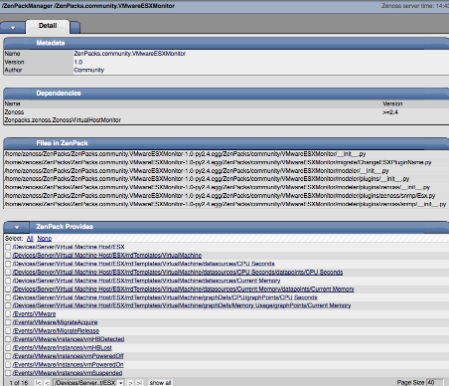Submitted by: Ryan Matte and David Nalley
Description:
This ZenPack allows you to monitor VMware ESX hosts and their guests.
- Extends ZenModeler to discover guests running on the ESX host.
- Provides screens and templates for collecting and displaying resources allocated to the guests.
- There is a link to the VMware Web interface on each ESX server Status page.
- If the name of the Guest under ESX is the same as the name of a device being monitored directly by Zenoss, a link is provided to take you directly to that device from the Guest list.
Screenshots:
REQUIREMENTS:
- Zenoss Version: 2.4
- ZenPack Dependencies: Virtual Host Monitor
- External Dependencies:
- Make sure you have SNMP connectivity to your ESX 3 servers.
- Using the VMware vSphere client, add Zenoss to the list of destinations for SNMP traps. (See Administration > vCenterServerSettings > SNMP.) For information about configuring traps for a stand-alone ESX 3 server, see "About SNMP and VMware Infrastructure" at:
http://www.vmware.com/pdf/vi3_35/esx_3/r35u2/vi3_35_25_u2_admin_guide.pdf - ESX servers (Version 4.x and higher) contain an SNMP subagent from VMware. This subagent provides all information related to VMware (such as virtual machines and their status). By default, the subagent is disabled.
- The VMware SNMP subagent does not provide information about the ESX server itself (such as processes, memory, CPU, or performance data).
Note that the VMware SNMP subagent cannot share port 161. If any other agent is using that port (usually the NET- SNMP agent), the subagent cannot start. - To fully monitor the ESX machine on your Zenoss server, you must enable both SNMP agents (NET-SNMP and the VMware subagent). Follow these steps to enable both agents using an SNMP proxy:
- Stop the snmpd service through the service console (via SSH) on the ESX host: service snmpd stop
- Add a proxy line to the /etc/snmp/snmpd.conf file:
proxy -v 1 -c public udp:127.0.0.1:171 .1.3.6.1.4.1.6876
This line will use the snmpd service to access the VMware MIB on the subagent running at port 171. - Using the VMware vSphere CLI (command line interface), bind the VMware SNMP agent to port 171, and then enable the subagent by using these commands:
vicfg-snmp.pl --server <hostname|IP address> --username <username> --password <password> -c public --port
vicfg-snmp.pl --server <hostname|IP address> --username <username> --password <password> -E - Via SSH, go back to the ESX host. Restart the mgmt-vmware service (hostd) and the snmp service. On the ESX host from the service, enter:
service mgmt-vmware restart
service snmpd restart
Source: http://zenpacks.zenoss.org/trac-zenpacks/browser/zenpacks/ZenPacks.community.VMwareESXMonitor
Tagged Releases:
Change History:
- 1.0 initial release
Trac tickets: http://zenpacks.zenoss.org/trac-zenpacks/report/1
Known issues:





